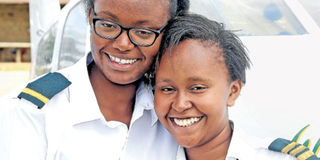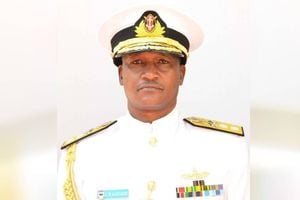Young, smart and determined to conquer the skies

Teckla Mwangi (left) and Juliet Ruku are both 19. Juliet is a flight instructor, while Teckla is studying for her commercial Pilot License. PHOTO|JEFF ANGOTE
What you need to know:
These two young women are part of the next generation of a growing number of female pilots in Kenya.
Teckla Mwangi and Juliet Ruku both got B+ in their Kenya Certificate of Secondary Education examinations in 2013.
This is not outstanding though, because there are hundreds of students that year who scored A in the same exams. What is outstanding is that at 19 years, Juliet already has her Private Pilot License (PPL) and Commercial Pilot License (CPL), with two years
of flight under her belt. She is targeting greater achievements than simply flying around the world.
“I’ve never heard of a woman who owns an airline – I would like to become the first one,” she says.
Teckla, also 19, is studying for a degree in mechanical engineering at the University of Nairobi alongside studying for her Private Pilot License (PPL). The teen started telling anyone who cared to listen that she would become a pilot when she was just three.
These two young women are part of the next generation of a growing number of female pilots in Kenya.
JULIET’S STORY
Her interest in planes and how they worked was almost inevitable, since her father, an electrical and mechanical engineer, would sometimes take her with him to work.
“My father worked at the Moi International Airport - I never tired of watching the gleaming planes resting majestically on the tarmac,” she says.
She was five at the time. Her interest in planes faded as she grew older though, only to be reignited in high school after watching a schoolmate fly an aircraft over the school and drop success cards.
“It annoyed me that the one doing the flying was a boy, not a girl,” she says, laughing at the memory.
That is when she decided that she would become a pilot. She was 15. During the school holidays, she would train at the Kenya School of Flying, based at Wilson Airport, Nairobi, for two to three weeks, for six hours daily.
Two years later, she was 17; she was ready for her first solo flight.
“It was just me in the cockpit, there was no instructor on board – the day before I had been unable to sleep due to anxiety and excitement. I was so elated that I was able to do it.”
After that solo flight, she decided that she would become an airline pilot. She is now a flight instructor at Kenya School of Flying, the same school that trained her.
“Life is too short, there are so many things that I want to do, and I am glad that I have already started doing them.”
She has big dreams; she wants to travel to every part of the world. She also wants to fly the Boeing 747-800 one day.
Juliet’s day begins at 5am with a prayer and a bit of reading. At 6am she leaves for work, where she normally arrives at 7.30am. She studies until 8.30am, and then instructs her students for four hours. She then takes her class in Multi-Engine and Instrument
Rating (MEIR) – this course teaches the student to fly twin engine aircraft with no visual external references, flying aircrafts in the same manner as airline pilots. She hopes to get her MEIR certification by March this year.
Normally, she leaves the office at 5 or 6pm.
She intends to pursue a degree in Criminal Justice Studies part time, as she completes her final course in MEIR. She also intends to take up bush flying and give commercial airline flying a try.
“I would like to work for Kenya Airways, but would consider British Airways if they bring back the Concorde model airplane. It flies faster than sound. It’s like two 787 combined, it is a double decker of a plane,” she says, face beaming.
TECKLA’S STORY
Teckla fell in love with the sound of planes as a child, craning her neck skyward as they flew past, staring until they disappeared into the horizon. She itched to know what it felt like to operate a plane, to fly it.
In high school, she and her friends would refer to each other by the titles of the careers they hoped to pursue. “My desk mate wanted to study medicine after high school, so I would call her Doctor Janice, while she would refer to me as Captain Teckla,”
she chuckles. Interestingly, her former deskmate, Janice, is now studying pharmacy at Jomo Kenyatta University of Agriculture and Technology (JKUAT).

Teckla Mwangi (left) and Juliet Ruku who are both 19 years old rom Kenya School of Flying during the interview on July 14, 2015. PHOTO| JEFF ANGOTE
Teckla, who will start studying for her Commercial Pilot license in April this year, is in her second year of study at the University of Nairobi, where she is pursuing a degree in mechanical engineering. She is one of 12 women in a class of 180 students.
“Though my parents supported my dream to become a pilot, they emphasised that it was necessary that I get a degree as well, since it would give me more leverage over others in this field,” she says, pointing out that her degree would be a good backup plan in case, for some reason, she could not fly anymore.
An average day for Teckla begins with a one-hour flight at 8am. At 9am, she leaves the airfield to study until around 12pm. At 2pm, she takes another hour of flying, and then calls it a day at 3.30pm.
“Each day you walk into the airfield, you discover something new about planes,” Teckla remarks.
“Flying takes a lot of concentration and care. You have to be smart and quick at what you do - there is also lots of Math, Physics and Geography involved in the learning,” she points out.
These two young women are not only an inspiration to their peers; their younger siblings also look up to them. Teckla’s younger brother is so impressed with her achievements; he wants to become a pilot too, while two of Juliet’s younger siblings want to work in the aviation industry, one as a pilot, the other as an astronaut.
You want to become a pilot? Punch the right buttons early
Start by visiting the Kenya Civil Aviation Authority (KCAA) website: www.kcaa.or.ke for approved training organisations, as well as a list of certified aviation security trainers. The organisation is based at Wilson Airport.
This is what it costs to become a pilot
• Private Pilot License (PPL)
Course duration: 4 – 6 months
Flight hours required: 45 hours
Cost: Ranges from Sh730,000 to 1.1M depending on the school you choose.
What you learn:
• Ground school instruction – This is an introduction to aviation as a whole, from communications to air/traffic control to meteorology, weight/balance, radio navigation and aeronautical charts
• General flight test
• Morse Code tutorial
• A final assessment is made by the Kenya Civil Aviation Authority (KCAA) examiner.
With this license, one can only fly privately owned aircrafts.
• Commercial Pilot License
Course duration: 8 – 12 months
Flight hours you obtain: 155 hours
What you learn:
• Ground School instruction - this is specific, and a build up from the PPL ground instruction with more information on commercial flights.
• Some schools break the course down to 14 subjects in addition to the hours of flight.
With this license, one can work with a commercial Airline.
Cost: Ranges from Sh2.5 to 2.9M depending on the school you choose.
• Initial Multi Engine/Instrument Rating
Course duration: Six weeks
Hours: 45 hours
Cost: Ranges from Sh1.25 to 1.5M shillings depending on the school you choose.
What you learn:
• 20 hours on an approved full motion simulator
• 25 hour on a Twin Seneca PA34 plane or other planes depending on your flight school of choice.
With this license, one gets more insight on flying twin engine aircrafts and managing an aircraft in varying intense weather with flight instruments.
***
Women pioneers in the field of aviation
In 2004, our very own Koki Mutungi became the first African woman to fly the Dreamliner, while Amy Kiiru is considered one of Kenya’s top 25 pilots. She is currently a pilot at Kenya Airways.
Further afield, at 26, Esther Mbabazi became the first female commercial pilot to fly Rwandair, while Asnath Mahapa is the first black woman in South Africa to become a pilot, and the first black female pilot trainee in South Africa.
Colonel Jacqueline Cochran (May 11, 1906 – August 9, 1980) was a pioneer in the field of American aviation. She is considered one of the most gifted racing pilots of her generation. She played a huge role in the formation of the wartime Women’s Auxiliary Army Corps (WAAC) and Women Airforce Service Pilots (WASP).
Born on July 24, 1897, Amelia Mary Earhart was the first female aviator to fly solo across the Atlantic Ocean, a record that saw her receive the U.S. Distinguished Flying Cross.
In 1911, Harriet Quimby was awarded a US pilot’s certificate by the Aero Club of America, becoming the first woman in the United States to get this honour.
Born Hannah Lincoln Harkness, Nancy Harkness Love was an American pilot and commander during World War II.
Born in 1892, Elizabeth “Bessie” Coleman, became the first female African American pilot and the first Native American woman to hold a pilot license.
French Raymonde de Laroche, born in 1882, was the first woman in the world to receive an aeroplane pilot’s licence.
French Thérèse Peltier is believed to be the first woman to pilot a heavier air craft.
Helen Richey was a pioneering female aviator, and the first woman to be hired as a pilot by a commercial airline in the United States.
Emily Howell Warner was the first woman captain of a scheduled US airline.
*At 23, Sabiha Gökçen, became the first Turkish female combat pilot.
Compiled by Pauline Ongaji





